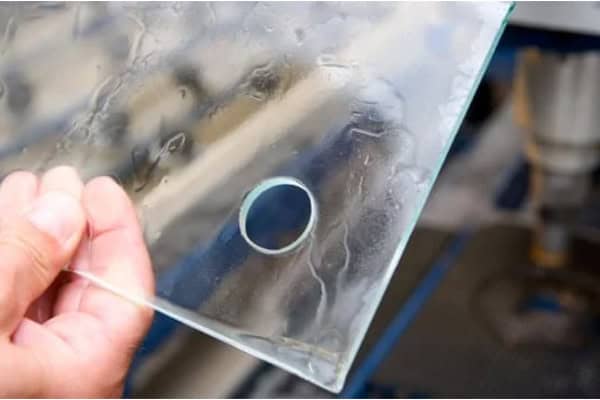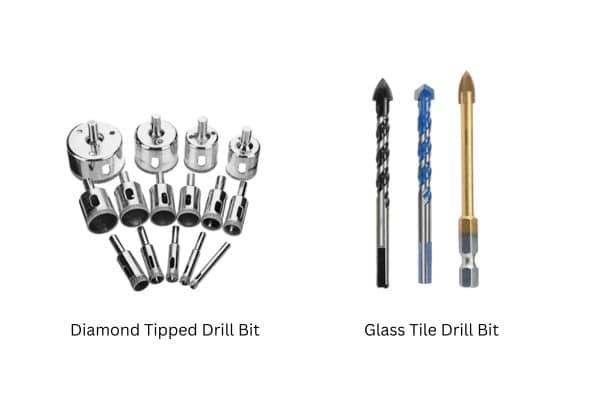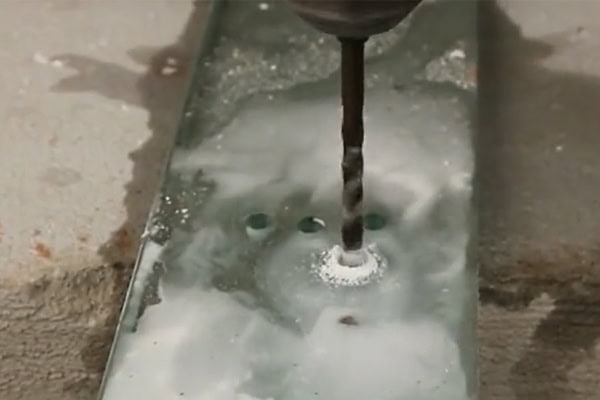
Drilling a hole in glass might sound like a risky task, but with the right tools, techniques, and a bit of patience, it’s entirely possible. Whether you’re working on a DIY project, creating a decorative piece, or need to install a fixture in a glass window, drilling into glass doesn’t have to be intimidating. In this guide, I’ll walk you through everything you need to know to drill a perfect hole in glass without cracking or shattering it.
Drilling holes in glass requires a careful approach, the right drill bits, and some patience. Using the correct drill bits and a few simple techniques, you can achieve a clean hole with no shattering. We’ll explore why glass is so delicate, the common mistakes to avoid, and how to choose the right equipment. Let’s dive into the process!
Now, let’s explore how to drill through glass without any mishaps, and I’ll share some tips and tricks that will make the job feel less daunting.
Best Bits to Use for Drilling Glass?
What drill bits should you use when drilling into glass?
Choosing the right drill bit is one of the most important steps in ensuring your project goes smoothly. Glass1 is a delicate material, and if you’re not careful, you can easily cause cracks or even shatter the whole thing.
The right drill bit is essential to drilling glass successfully. The best drill bits for glass are typically diamond-tipped or specifically designed glass and tile bits. These bits are designed to handle the hardness and delicate nature of glass without cracking or shattering the surface. When in doubt, go for diamond-tipped bits—they’re the most effective.
Types of Drill Bits
Choosing the right drill bit can make all the difference when drilling glass. Here’s a breakdown of the top options you should consider:
1. Diamond-Tipped Drill Bits
Diamond-tipped bits are the best choice when drilling glass. They’re made with industrial-grade diamonds and are designed for extreme durability. These bits provide the strength and precision necessary to pierce through glass without applying excessive force. Since diamond is harder than glass, it can cut smoothly through the material while reducing the risk of fractures or shattering.
Diamond bits are often used for professional-grade projects, but with a little practice, they’re perfect for home use as well. You’ll typically find these bits in a variety of sizes and shapes, making them versatile for all types of glass drilling tasks. They are especially useful for thicker glass2, such as glass tabletops or windows.
A common misconception is that you need to apply a lot of pressure for the bit to do its job. In reality, it’s about applying slow, steady force and letting the diamond-tipped bit do most of the work. It’s important to keep the bit cool while working, which brings us to the next point: lubrication.

2. Glass and Tile Drill Bits
If you’re on a budget or dealing with thinner glass, glass and tile drill bits are a good alternative. These bits are designed specifically for glass, ceramics, and tiles. They often have a spearhead or pointed tip that prevents the bit from slipping as you begin drilling. These bits are usually made from carbide, which is strong enough to handle most glass projects but not as durable as diamond-tipped bits.
Glass and tile bits are more affordable and are often found in basic DIY toolkits. They’re ideal for smaller holes and thinner glass, like picture frames or small vases. However, they require more attention to detail when drilling, as they tend to overheat more quickly and may need to be cooled down regularly.
Some people prefer these bits for lighter DIY tasks because they’re easy to find and use. However, be sure to use light pressure and a slow speed when drilling to prevent cracks.
How to Select the Right Drill Bit for Your Project
- For thicker glass (e.g., windows or tabletops): Diamond-tipped bits are the best choice for durability and precision.
- For thinner glass (e.g., bottles or small glass pieces): Glass and tile bits will get the job done without breaking the bank.
- For larger holes or professional projects: Opt for diamond-tipped bits for a cleaner, more controlled cut.
Tips for Drilling Glass
- Use a slow speed: High-speed drilling increases the risk of cracks. Always use a slow, steady pace to avoid excess heat and pressure.
- Stabilize the glass: Keep the glass stable by using a clamp or placing it on a non-slip surface to prevent it from shifting.
- Use a guide: A drill guide can help ensure a clean, straight hole.
How are People Able to Drill Glass Without Shattering It?
Why doesn’t glass always break when drilled?
It might seem like glass would inevitably shatter as soon as a drill touches it, but there’s more to the process than meets the eye. The key to successful glass drilling lies in technique and control. Glass is a fragile material, and it’s all too easy to cause cracks or fractures if you’re not careful.
To drill glass without cracking it, you need to control the pressure, minimize heat buildup, and keep the glass cool. The process requires slow, consistent movements to minimize the stress on the material.
The Science Behind Drilling Glass
Glass is actually a material that can withstand a surprising amount of pressure when applied evenly. The problem arises when uneven pressure is applied or when too much heat is generated, leading to cracks. Unlike softer materials like wood or plastic3, glass is much more sensitive to pressure changes, so it’s important to drill at a slow pace and apply minimal force.
When drilling, the goal is to minimize the risk of thermal shock. Thermal shock occurs when one part of the glass gets too hot or cold too quickly. This difference in temperature causes stress and, in turn, can lead to fractures.
Tips to Prevent Cracking or Shattering:
- Start with a small pilot hole: A smaller pilot hole guides the larger drill bit and minimizes the risk of cracks by reducing initial pressure on the glass.
- Use masking tape: Apply a piece of masking tape over the spot where you plan to drill. This helps to reduce the friction and prevents the drill bit from slipping.
- Drill from the backside: Drilling from the backside of the glass can help minimize visible cracks or chips on the front surface. If possible, try to support the glass so that the force is applied evenly from the back.
By following these tips, you can successfully drill through glass without causing cracks, ensuring a smooth and clean hole.

How to Drill Glass at Home?
Is it possible to drill glass at home with everyday tools?
Absolutely! Drilling glass at home is achievable with the right tools4 and a bit of preparation. You don’t need to be a professional to drill a hole in glass—many people tackle this task successfully with basic home tools.
You can drill glass at home using simple tools like a drill, a specialized drill bit, and a few precautions. The key is patience and following a methodical approach to avoid damaging the glass. Let’s break down the steps for a successful DIY glass drilling experience.
Steps to Drill Glass at Home
- Mark the Spot: Measure and mark the area where you want to drill the hole. Use a pencil or a non-permanent marker. Applying masking tape over the mark will keep it in place and prevent the drill bit from slipping.
- Prepare the Surface: Place the glass on a flat, stable surface. Make sure the glass is supported evenly, so it won’t shift during drilling. Use clamps if necessary to secure the glass in place.
- Choose the Right Drill Bit: For best results, use either a diamond-tipped or a glass and tile drill bit, depending on the thickness of the glass.
- Start with a Pilot Hole: If you’re working with thick glass, it’s a good idea to drill a small pilot hole first. This smaller hole will act as a guide for the larger bit, ensuring you have more control during the drilling process.
- Drill Slowly and Gently: Apply light pressure and keep the drill on a slow speed. Don’t force the drill bit through the glass—let it gradually do the work. Keep the bit cool by using water or a damp cloth.
- Take Your Time: Don’t rush the process. Drilling glass takes time, so be patient. Forcing the drill too quickly can increase the risk of cracking.

Pro Tips for Home Glass Drilling:
- Wear protective gear: Always wear safety goggles and gloves to protect yourself from glass shards.
- Use a firm, flat surface: Ensure the glass is fully supported and won’t move during drilling. Use a non-slip mat or rubber surface for added stability.
- Don’t apply too much pressure: Let the drill bit gradually work through the glass instead of pushing too hard, which could crack it.
Essential Tips for Drilling Holes into Glass
So, what’s the secret to drilling glass perfectly?
The key to drilling glass without any mishaps is all about control and technique. There are a few tricks that will help you get through the process with ease.
When drilling into glass, slow and steady wins the race. Let’s go over some crucial advice to keep in mind for a successful project.
Top Tips for Drilling Glass
- Drill slowly and steadily: Fast speeds increase the likelihood of cracking. Use a low-speed drill to minimize heat buildup and avoid applying excessive pressure.
- Keep the area cool: Drilling can heat up the glass quickly, leading to cracks. Use water or a damp cloth to cool the area as you drill. Some people even prefer drilling under water for the best results.
- Use a guide: A clamp or a drill guide can stabilize the glass and keep it from shifting, helping you achieve a clean, straight hole.
- Be patient: Drilling glass isn’t a race. Take your time, and don’t force the drill bit through the glass.
Conclusión
Drilling holes in glass isn’t as daunting as it seems. With the right drill bits, technique, and patience, you can create clean, accurate holes in glass without worrying about cracks or shattering. Just remember to take your time, keep things cool, and go slow. Before you know it, you’ll be drilling like a pro!
-
Specific precautions need to be taken to avoid cracking or shattering. It offers more in-depth advice and expertise on the material itself, which is essential for a successful project. ↩
-
Diamond bits can withstand the increased resistance without breaking or losing sharpness, making them perfect for tough jobs like glass tabletops or windows. ↩
-
Guide users to resources explaining why materials like plastic are less sensitive to pressure changes, making them easier to drill than glass. ↩
-
Offer further insights into the specific tools required, including drill bits designed for glass, which is crucial for successful drilling and avoiding damage. ↩